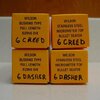Allen One1
Member
I'm having some case sizing issues that I haven't gotten figured out yet but have been looking around at new dies this afternoon.
Does anyone have any experience or opinions on Forster vs Mighty Armory sizing dies. Both look good for different reasons the Forster you can have honed to fit your specific needs and the Mighty Armory looks to have very exacting machining specs.
6.5 Creedmoor
Bolt Gun
Long Range Targets
Does anyone have any experience or opinions on Forster vs Mighty Armory sizing dies. Both look good for different reasons the Forster you can have honed to fit your specific needs and the Mighty Armory looks to have very exacting machining specs.
6.5 Creedmoor
Bolt Gun
Long Range Targets





